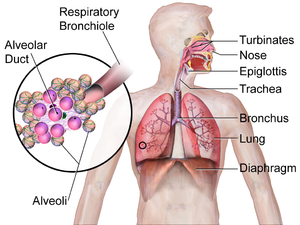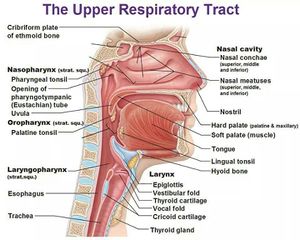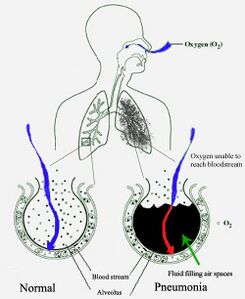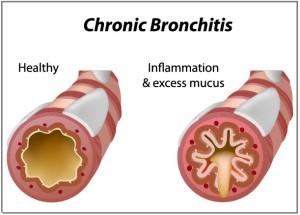Sputum
Original Editor - Lucinda hampton
Top Contributors - Lucinda hampton and Kim Jackson
Introduction[edit | edit source]
Sputum is matter expectorated from the respiratory system (and especially the lungs). It is composed of mucus but may contain pus, blood, fibrin, or microorganisms (such as bacteria) in diseased states.[1] Sputum is produced when a person’s lungs are diseased or damaged. Sputum is not saliva but the thick mucus (sometimes called phlegm) which is coughed up from the lungs.
- The body produces mucus to keep the thin, delicate tissues of the respiratory tract moist so that small particles of foreign matter that may pose a threat can be trapped and forced out.
- Sometimes, such as when there is an infection in the lungs, an excess of mucus is produced. The body attempts to get rid of this excess by coughing it up as sputum.[2]
Mucous[edit | edit source]
Mucus is the first line of defense for the various epithelia inside our body against harmful pathogens. Its job also entails the protection of the epithelium from the excoriating irritants found in the gastrointestinal tract. It houses an assemblage of proteins such as immunoglobulins, various glycoproteins and some antimicrobial enzymes eg lysozymes. The cross-bridging of polymeric gel-forming mucins chiefly determines the biophysical properties of mucus. This layer is very protective against bacteria through bacterial growth inhibition and the prevention of biofilm formation. The mucus layer also works as a physical barrier against respiratory irritants and prevents fluid loss as well. Expectorated mucus is called sputum.
The amount of mucus in our body is regulated chiefly by two mechanisms, which are the mucus-secreting cells and the mucociliary escalator. Goblet cells of the mucous membranes and the submucosal glands of the respiratory, GI, and reproductive systems are responsible for the secretion of mucus, and the mucociliary escalator is responsible for the clearance of mucus towards the pharynx, where it is eventually expectorated out by the cough reflex.[3]
Sputum Examination[edit | edit source]
The sputum is examined grossly and microscopically to aid medical diagnosis. The sputum contains various cells and molecular compounds such as soluble lipids and proteins. Its analysis is crucial in medicine. The sputum analysis involves an analytical approach to investigate the cellular and acellular components expelled from the patient's upper respiratory tract. This procedure is essential in the evaluation and management of lower respiratory infections or other longstanding health conditions. Clinically, sputum molecular biomarkers or gene sequencing of the microorganisms have increased medicine accuracy and represent a milestone in the current evaluations of the algorithms running for precision medicine.[4]
Diagnosis[edit | edit source]
Sputum analysis's diagnostic results involve many different diseases, such as respiratory infections, lung cancers, and non-cancerous lung conditions.
- Pneumonia is the most common lung infection disease and may relate to potential spreading. Untreated pneumonia may lead to severe complications.
- Lung cancer is ranked the fourth most commonly diagnosed malignancy in developed countries, and the first in cancer-caused death worldwide.[4]
Disease States[edit | edit source]
There are many different reasons for the body to produce excess sputum. Excessive mucus production overwhelms the mucociliary clearance mechanisms, thus leading to the accumulation of this excess mucus. This leads to the formation of mucus plugs, which further decrease the clearance. The airways respond by secreting an excess of inflammatory mediators in an attempt to clear the obstruction. Unfortunately, this only worsens the condition as mucus viscosity becomes increased, leading to further decreased clearance as well as the initiation of inflammation and fibrosis. This condition is only worsened by the fact that this static mucus is invaded by bacteria like Pseudomonas aeruginosa and Staphylococcus aureus. Thus, a vicious cycle initiates, which invariably ends with an acute exacerbation of the condition.[3]A list of some of these causes of excess mucous production follows:
- Cystic Fibrosis
- Tuberculosis
- Chronic Airway irritation (leads to mucous hypersecretion) eg Smoking, COPD and asthma, .[3]
The Significance of Different Sputum Types[edit | edit source]
Sputum characteristics can provide much information.[5]
| Type | Characteristics | Associated pathology |
| Purulent | Thick, yellow/green sputum | Infectious – pneumonia, bronchiectasis and abscess |
| Mucoid | Clear, grey/white | Chronic obstructive pulmonary disease and asthma |
| Serous | Clear, frothy, can be pink | Pulmonary oedema |
| Blood | Blood | Malignancy, pulmonary embolus, clotting disorders, infection |
Physiotherapy[edit | edit source]
Chest physiotherapy is the term for a group of treatments designed to eliminate secretions, thus helping to decrease work of breathing, promote the expansion of the lungs, and prevent the lungs from collapse. For treatments see Respiratory Physiotherapy
Resources[edit | edit source]
- bulleted list
- x
or
- numbered list
- x
References[edit | edit source]
- ↑ Merriam Webster Sputum Available: https://www.merriam-webster.com/dictionary/sputum (accessed 8.7.2021)
- ↑ Medical News Today What can sputum tell us. Available: https://www.medicalnewstoday.com/articles/318924 (accessed 8.7.2021)
- ↑ 3.0 3.1 3.2 Gupta R, Wadhwa R. Mucolytic Medications. [Updated 2021 May 10]. In: StatPearls [Internet]. Treasure Island (FL): StatPearls Publishing; 2021 Jan Available: https://www.ncbi.nlm.nih.gov/books/NBK559163/#!po=88.4615 (accessed 8.7.2021)
- ↑ 4.0 4.1 Shen F, Sergi C. Sputum Analysis. [Updated 2020 Oct 18]. In: StatPearls Available:https://www.ncbi.nlm.nih.gov/books/NBK563195/ (accessed 8.7.2021)
- ↑ OME Types of Sputum Available: https://www.oxfordmedicaleducation.com/clinical-examinations/respiratory-examination/sputum-types/ (accessed 8,7,2021)










